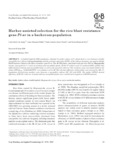Please use this identifier to cite or link to this item:
http://www.alice.cnptia.embrapa.br/alice/handle/doc/862208| Title: | Marker-assisted selection for the rice blast resistance gene Pi-ar in a backcross population. |
| Authors: | ARAÚJO, L. G. de  PRABHU, A. S.   PEREIRA, P. A. A.   SILVA, G. B. da   |
| Affiliation: | LEILA GARCÊS DE ARAÚJO, UFG ANNE SITARAMA PRABHU, CNPAF PEDRO ANTONIO ARRAES PEREIRA, CNPAF GISELE BARATA DA SILVA, UFV. |
| Date Issued: | 2010 |
| Citation: | Crop Breeding and Applied Biotechnology, v. 10, n. 1, p. 23-31, Mar. 2010. |
| Description: | A doubled-haploid (DH) population, obtained by anther culture of F 1 plants from a cross between a highly susceptible rice cultivar Lijiangxintuanheigu and the resistant somaclone (SC09), of the cultivar Araguaia, was used to identify RAPD markers linked to the blast resistance gene Pi-ar. The 86 DH plants, inoculated with the race IB-9 of Magnaporthe oryzae, segregated in 1:1 ratio of resistant and susceptible plants. Of the 67 primers used 31 produced DNA profiles that differentiated resistant and susceptible bulks as well as the parental cultivars. The resistance gene was found linked to the primer OPS162072 (?AGGGGGTTCC?) at a distance of 3.6 cM. The selection efficiency of this primer was assessed in a BC3 F1 population derived from another cross between a susceptible cultivar IAC 201 and SC09. The marker OPS16 showed efficiency of 86.9%, when six resistant and two susceptible plants were considered as negatives in RAPD analysis. |
| Thesagro: | Arroz Oryza sativa Antera Brusone Doença de planta Marcador molecular |
| NAL Thesaurus: | Rice Doubled haploids Anther culture Magnaporthe grisea |
| Keywords: | Duplo haplóide |
| Type of Material: | Artigo de periódico |
| Access: | openAccess |
| Appears in Collections: | Artigo em periódico indexado (CNPAF)  |
Files in This Item:
| File | Description | Size | Format | |
|---|---|---|---|---|
| c8eb9793.pdf | 416,46 kB | Adobe PDF |  View/Open |









